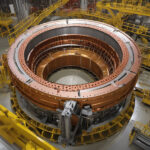Europe Cools Giant 20-ton Magnets at -456°F for 10x Particle Collision Boost
Engineers at CERN are closing in on the completion of a crucial test facility for the next generation of particle accelerators. This facility includes a groundbreaking system that involves cooling massive 20-ton magnets to a mind-boggling temperature of -456°F (-271°C). The purpose? To significantly boost particle collisions and pave the way for exciting new discoveries in the world of particle physics.
The European Organization for Nuclear Research (CERN) is known for pushing the boundaries of scientific research, and their latest endeavor is no exception. By subjecting these colossal magnets to such extreme cold, CERN scientists are able to achieve superconductivity, a state in which the electrical resistance of the magnets drops to zero. This allows for the efficient generation of powerful magnetic fields necessary to steer particle beams around the accelerator ring.
But why the need for such low temperatures? The answer lies in the unique properties of superconducting materials. When cooled to temperatures approaching absolute zero, these materials exhibit zero electrical resistance and expel magnetic fields, enabling the magnets to carry immense currents without any energy loss. This, in turn, results in stronger magnetic fields that can bend and focus particle beams with unprecedented precision.
The implications of this technological feat are profound. By enhancing the efficiency of particle acceleration and collision, scientists at CERN are poised to unlock new frontiers in particle physics. The increased collision rates made possible by the supercooled magnets will provide researchers with more data to analyze, offering deeper insights into the fundamental building blocks of the universe.
One of the key projects that will benefit from this technological advancement is the High-Luminosity Large Hadron Collider (HL-LHC), set to be operational by the mid-2020s. This upgraded version of the world’s largest and most powerful particle accelerator will harness the enhanced collision capabilities enabled by the supercooled magnets to increase the number of collisions by up to a factor of 10. Such a boost in collision rates will not only allow scientists to explore rare particle interactions but also increase the sensitivity of experiments searching for new particles beyond the Standard Model of particle physics.
Moreover, the innovations pioneered at CERN could have far-reaching implications beyond the realm of fundamental science. The technologies developed to cool and operate these superconducting magnets could find applications in fields such as medical imaging, energy production, and even transportation.
As Europe continues to push the boundaries of scientific exploration with its ambitious particle accelerator projects, the world is poised to benefit from the groundbreaking discoveries that lie ahead. By harnessing the power of superconductivity and extreme cold, CERN is opening the door to a new era of discovery that promises to reshape our understanding of the universe.
#CERN #ParticlePhysics #Superconductivity #Innovation #ScientificResearch












